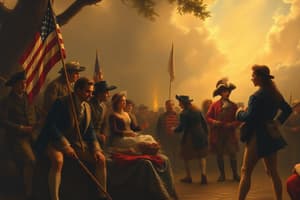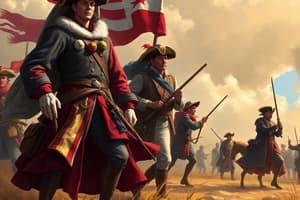Podcast
Questions and Answers
What were the Loyalists during the Revolution?
What were the Loyalists during the Revolution?
- People loyal to the British Crown (correct)
- Colonists advocating for British taxes
- Supporters of the Continental Army
- A political group advocating independence
What was the Society of the Cincinnati?
What was the Society of the Cincinnati?
An elite group formed by Continental Army officers in 1783.
What does primogeniture refer to?
What does primogeniture refer to?
- A system of shared property among siblings
- A law that promotes female inheritance rights
- The first born son receives all of the inheritance (correct)
- The idea of equal inheritance among children
What did the Protestant Episcopal Church evolve from?
What did the Protestant Episcopal Church evolve from?
What was the Virginia Statute for Religious Freedom?
What was the Virginia Statute for Religious Freedom?
What did the Philadelphia Quakers achieve in 1775?
What did the Philadelphia Quakers achieve in 1775?
What do interracial marriage laws signify?
What do interracial marriage laws signify?
What was unique about the New Jersey constitution in 1776?
What was unique about the New Jersey constitution in 1776?
Who was Abigail Adams?
Who was Abigail Adams?
What is civic virtue?
What is civic virtue?
What does republican motherhood refer to?
What does republican motherhood refer to?
What did Elizabeth 'Mumbet' Freeman do in 1781?
What did Elizabeth 'Mumbet' Freeman do in 1781?
What is republicanism?
What is republicanism?
What happened to Loyalist properties, such as Roger Morris's estate?
What happened to Loyalist properties, such as Roger Morris's estate?
What is significant about the Brandywine Creek?
What is significant about the Brandywine Creek?
What was the Empress of China?
What was the Empress of China?
What were the Articles of Confederation?
What were the Articles of Confederation?
Why was the governing body kept weak under the Articles of Confederation?
Why was the governing body kept weak under the Articles of Confederation?
When was Independence Hall built?
When was Independence Hall built?
What was Thomas Jefferson's stance on the Articles of Confederation?
What was Thomas Jefferson's stance on the Articles of Confederation?
What is the Old Northwest?
What is the Old Northwest?
What did the Land Ordinance of 1785 establish?
What did the Land Ordinance of 1785 establish?
What are townships in the context of the Northwest Ordinance?
What are townships in the context of the Northwest Ordinance?
What did the Northwest Ordinance of 1787 dictate?
What did the Northwest Ordinance of 1787 dictate?
What did Lord Sheffield promote in his pamphlet?
What did Lord Sheffield promote in his pamphlet?
What actions did Spain take towards America?
What actions did Spain take towards America?
Who was John Jay?
Who was John Jay?
What does the term 'King Congress' imply?
What does the term 'King Congress' imply?
What is rag money?
What is rag money?
What was Shays's Rebellion?
What was Shays's Rebellion?
Who led Shays's Rebellion?
Who led Shays's Rebellion?
What is meant by 'cement to the Union'?
What is meant by 'cement to the Union'?
Who emerged as a major political figure during the Constitution debate?
Who emerged as a major political figure during the Constitution debate?
When did the Constitutional Congress start?
When did the Constitutional Congress start?
What was Rhode Island's stance on the Constitutional Convention?
What was Rhode Island's stance on the Constitutional Convention?
Why did Jefferson refer to delegates as demigods?
Why did Jefferson refer to delegates as demigods?
Who was George Washington in the context of the Constitutional Convention?
Who was George Washington in the context of the Constitutional Convention?
What role did James Madison play?
What role did James Madison play?
What was the threat posed by the Dey of Algiers?
What was the threat posed by the Dey of Algiers?
What was the large-state plan?
What was the large-state plan?
What does unicameral mean?
What does unicameral mean?
What was the small-state plan?
What was the small-state plan?
What was the Great Compromise?
What was the Great Compromise?
Who is Gouverneur Morris?
Who is Gouverneur Morris?
What is the Electoral College?
What is the Electoral College?
What does the three-fifths compromise refer to?
What does the three-fifths compromise refer to?
What was unique about the Georgia state constitution?
What was unique about the Georgia state constitution?
What was the Constitutional Convention?
What was the Constitutional Convention?
What is the term 'triple-headed monster' referring to?
What is the term 'triple-headed monster' referring to?
Who are the antifederalists?
Who are the antifederalists?
Who are the federalists?
Who are the federalists?
What became known as the District of Columbia?
What became known as the District of Columbia?
When was the Constitution ratified?
When was the Constitution ratified?
Which states did not agree to ratification initially?
Which states did not agree to ratification initially?
What were The Federalist essays about?
What were The Federalist essays about?
What is a confederation?
What is a confederation?
What is a federation?
What is a federation?
What are checks and balances?
What are checks and balances?
What is sovereignty?
What is sovereignty?
What is popular sovereignty?
What is popular sovereignty?
What is mobocracy?
What is mobocracy?
What does 'consent of the governed' mean?
What does 'consent of the governed' mean?
What are states' rights?
What are states' rights?
What is anarchy?
What is anarchy?
What is meant by 'bundle of compromises'?
What is meant by 'bundle of compromises'?
What is the Constitution?
What is the Constitution?
What is a section in land terms?
What is a section in land terms?
What is a quorum?
What is a quorum?
Why was Annapolis significant?
Why was Annapolis significant?
What is reapportionment?
What is reapportionment?
What is gerrymandering?
What is gerrymandering?
What region is referred to as the Sun Belt?
What region is referred to as the Sun Belt?
What is the Rust Belt?
What is the Rust Belt?
What is the approximate population of the U.S.?
What is the approximate population of the U.S.?
What is the approximate population of California?
What is the approximate population of California?
What is Detroit known for?
What is Detroit known for?
Which state has the highest unemployment rate?
Which state has the highest unemployment rate?
What is the citizens committee tasked with?
What is the citizens committee tasked with?
Who are the LA County district supervisors?
Who are the LA County district supervisors?
How many states are needed to ratify an amendment?
How many states are needed to ratify an amendment?
What is the ERA proposal?
What is the ERA proposal?
Who is Boehner?
Who is Boehner?
Flashcards are hidden until you start studying
Study Notes
Loyalists and the Revolution
- Loyalists were individuals who remained loyal to the British Crown during the American Revolution, with approximately 80,000 leaving America, creating space for Patriot supporters.
Societal Changes and Movements
- The Society of the Cincinnati was formed by Continental Army officers in 1783, perceived as elitist and aristocratic by others.
- Primogeniture laws, granting inheritance to the firstborn son, were transformed post-Revolution.
- The Protestant Episcopal Church emerged as the reformed version of the Anglican Church, adapting after losing its royal connections.
- Virginia Statute for Religious Freedom, enacted in 1786 due to Thomas Jefferson's initiatives, marked a significant step in separating church and state.
- Philadelphia Quakers established the first antislavery society in 1775, opposing the trade of "black ivory."
Women's Rights and Civic Duty
- Interracial marriage laws emerged alongside abolition efforts, highlighting limitations in the application of revolutionary ideals.
- The New Jersey constitution of 1776 temporarily permitted women to vote, showcasing early moves towards women's suffrage.
- Abigail Adams famously expressed to her husband the future potential of women to demand their rights.
- Civic virtue emphasizes that democracy relies on citizens' unselfish commitment to the public good.
- Republican motherhood defined women's roles in educating children about civic virtue, elevating their status as moral guardians of the nation.
Abolition and Notable Figures
- Elizabeth "Mumbet" Freeman successfully sued for her freedom in 1781 after being inspired by concepts of human rights.
- The philosophy of republicanism stressed limited government and elected representatives accountable to the people.
Governance and the Articles of Confederation
- The executive and legislative branches under the Articles of Confederation were intentionally weakened, reflecting public distrust of former royal authority.
- The Articles of Confederation (1777) was the nation's first constitution but was limited due to state dominance over powers like tax and trade regulation, leading to its nickname as "Articles of Confusion."
Economic Challenges and Shays's Rebellion
- Shays's Rebellion in 1786 highlighted the struggles of Massachusetts farmers, especially veterans losing their farms, igniting fears among the wealthy regarding democratic excesses.
Constitutional Convention and Alternative Plans
- The Constitutional Convention, beginning on May 25, 1787, aimed to revise the Articles of Confederation but ultimately led to a new Constitution.
- Virginia's large-state plan advocated for representation based on population, while New Jersey's small-state plan called for equal representation.
- The Great Compromise blended these plans, resulting in a bicameral legislature with both population-based and state-equal representation.
Key Figures and Influences
- Alexander Hamilton became a prominent Federalist leader during the Constitution debates and contributed to the Federalist Papers.
- James Madison, known as the "Father of the Constitution," played a crucial role in drafting the document and its amendments.
Ratification and Opposing Views
- The Federalist essays promoted the Constitution's ratification, while antifederalists opposed a strong central government, advocating for state independence.
- The ratification process saw Virginia, New York, North Carolina, and Rhode Island initially refusing to sign but ultimately conceding knowing the survival of independent states was at stake.
Government Structure and Powers
- The Constitution created a federal government with checks and balances to prevent abuse of power, relying on the consent of the governed.
- Popular sovereignty emphasized the role of the people in governmental authority, while states’ rights highlighted the balance of power between federal and state governments.
Population and Demographic Changes
- The U.S. population was approximately 309 million, with California alone comprising around 37 million, distributing House seats based on this population.
Modern Implications
- Issues like gerrymandering and reapportionment emerged in state politics, influencing representation based on census results.
- The Equal Rights Amendment (ERA) aimed to establish equal rights regardless of gender but faced challenges in state ratification.
Conclusion
- The Constitution remains a living document, subject to amendment and re-interpretation, reflecting the evolving values and demographics of the nation.
Studying That Suits You
Use AI to generate personalized quizzes and flashcards to suit your learning preferences.




